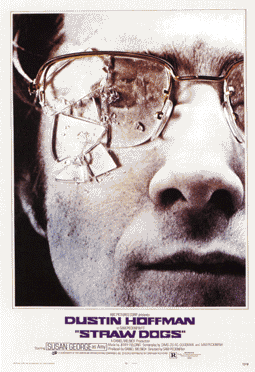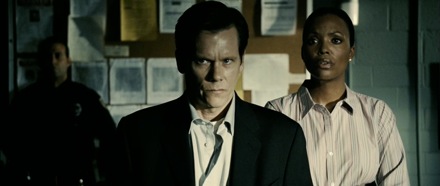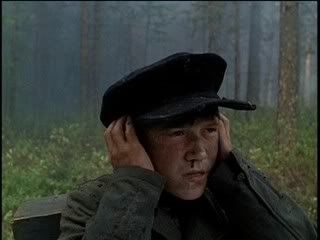Peckinpah, 1971

Sam Peckinpah’s Straw Dogs has always been somewhat of a black sheep in the world of cinema. When the film came out it was bombarded with criticism and controversy over the violence, and while decades later the controversy has died down, the film still sharply divides opinion in movie circles. Roger Ebert for example, hates the film. Others swear it as the best film Peckinpah ever made. Truth be told, it is easy to see why someone wouldn’t like, or even hate the film. It is a film that intentionally upsets the viewer’s preconceptions of what a movie and a narrative should be, and shatters the idea of what a ‘protagonist’ should act like. But despite this, I would still recommend most people check Straw Dogs out, because it is such a deep and layered film with so much to say that it would be a shame if someone missed an opportunity to experience this shocking, ultraviolent character study of a masterpiece.
Straw Dogs is set in Britain, in the foggy, obscure country side where David Sumner, a mathematician, and his wife Amy (Susan George) have just moved from America to supposedly get away from the social upheaval of the 1960s and 70s and live in a more peaceful environment where David can do his work. As the film progresses, it observes the playful but deteriorating marriage of the two leads, while at the same time focusing on the locals who are not too accepting of an American moving into their quaint village. David has hired a number of the rather conspicuous locals to fix up his roof, but they start to pick on him, making fun of him behind his back. David knows this, but he is a pacifist and doesn’t want conflict, so he lets it slide. But as time goes on, the men he hired to just fix his roof get more and more bold, their ‘practical jokes’ becoming ever more invasive and even dangerous.
The real meat to Straw Dogs lies in the character of David and the films incredible subtext on violence, which is not always dangled in front of the audience for easy digestion but instead requires you to step back and really think about what the film was really saying. David Sumner: Simple, inoffensive mathematician. The film actually gets the audience to sympathize with David at first because he really doesn’t seem like a bad guy. He may be a little meek, and seems a bit too caught up in his math, but he still comes off as a likeable type of guy. His wife, Amy, is a beauty but is completely the opposite of David. She doesn’t seem to appreciate his work, she is much more outgoing and promiscuous than him, and while there are a few early scenes where they seem happy together, you soon get the feeling that she is quite bored in their relationship. After a while, you begin to question both what she saw in David in the first place, and why she continues to stay with him.
As Straw Dogs progresses, poor relations between David and Amy become much more apparent. David just wants to be left in peace, and Amy feels bored and unappreciated. She gets into many fights with David, but David is a pacifist. He doesn’t like conflict, he doesn’t want to fight. But Amy ever so subtly pushes him and pushes him, and you can tell how much David is growing weary of her. When alone, he curses her under his breath. But never actually does so around her, because again, he is a pacifist and simply doesn’t want to rock the boat. David’s pacifism becomes an important aspect of Straw Dogs, because all his anger and frustration is never vented – it just continues to grow and grow inside of him. The film is such a fascinating character study in this aspect, because it explores just how much a human can take until he is brought to his breaking point.
The breaking point comes in the form of the rather miserable looking locals he hired to fix his roof. They don’t like the American, though it is never really explained why. It could be they feel threatened by a foreigner ruining their way of living, or it could be they are jealous of his alluring wife, which is a whole other topic which could be extensively explored on its own. But the men taunt and tease David, and later they begin to outright torment him. Since David is so non-confrontational, they see him as an easy target to bully. He never fights back, and in fact tries to remain quite polite towards them. But as their pranks turn to the morbid and the outright dangerous, David draws closer and closer to snapping. Straw Dogs studies David with a magnifying glass, and with every slight insult you can see David growing increasingly enraged, though he never lets on to anyone that the anger is growing inside him.
Eventually, the locals lure the easy to take advantage of David on a ‘hunting trip’, but of course end up stranding him in the wilderness. This is a dark turn in Straw Dogs, because while David is sitting in the middle of nowhere, the men go back to his house and confront his wife. What starts as a simple drink soon turns to lust, and before Amy knows it she is being beat by one of the men into submission and subsequently a rape occurs. This is the first major instance of violence in Straw Dogs, and it’s an important one because after a while Amy actually ends up smiling and she stops struggling. A lot of people felt extremely put off by this, but it simply is a case of Peckinpah making the audience feel uneasy about the violence. The rape seems almost worse in that she actually ends up liking it, and the rape often cuts to David who is bumbling around with a shotgun in the middle of nowhere while it is happening, as if to add insult to injury. David finally accepts that the others have long ago left, and ends up walking home in a sort of pathetic acceptance. David probably knew something like that would happen, yet he was too weak to say no.
When David gets home, he tells Amy he is fed up with the workers and that he will fire them the next day. Interestingly, Amy doesn’t say a word about the rape. It is as if she is so sick of his passiveness, that the rape was almost a way of getting back at him, and while she seems haunted by it, she perhaps relishes the fact that David has no idea what happened. She didn’t want the rape to happen, but while it was happening she found pleasure in the fact that David had no idea what was going on. And while she is haunted by it afterwards, she enjoys the thought of the dumb, fumbling David being none-the –wiser, and she doesn’t tell him. This is simply one of the many fascinating facets of Straw Dogs which could be explored entirely on its own.
However, the focus of this exploration is on David. He ends up firing the local men who basically shrug and walk away; the only real reason they probably even bothered showing up was to taunt him in the first place. This would have been the end of David’s problems with his bullies, but unfortunately for him a bizarre turn of events occurs and he ends up hitting a child rapist who is being hunted by the village with his car in the fog of the night. David does not know who the man is or that he is being hunted, however, and ends up taking him to his house, calling the local pup to see about getting a doctor. The men looking for the rapist are told where he is being held, and they set off for David’s home. This is what leads to the brutal conclusion of Straw Dogs, a sequence that is impossible to forget.
The men end up barging into David’s home and demand he turn the rapist over to him. But David has had enough. This is the last straw for him. He refuses to turn the rapist over, knowing he will be beaten and probably killed. The locals get physical with David and push him to the edge. David’s pacifism has been taken advantage of for too long. He decides to finally stand up to his bullies and kicks them out. It is interesting to point out, however, that David is not doing this because he cares about the rapist's well being. David is not a noble knight, he actually doesn’t really care about the guy. This is a very interesting part of the film, as David turns out to be a pretty despicable person when it comes to his motivations.
The men end up laying siege to David’s home and the violence erupts. At this point, David sees a chance to finally vent all his anger and rage – everything that has been building up. But the final sequence isn’t just about him venting his anger over the torment the men put him through. It is broader in that this sequence marks a point where David finally knocks down the walls of his passive idleness. He moved from America because he couldn’t stand the political turmoil. He became distanced and alienated from his wife because she was confrontational and always on his case. The local men were the last straw, they drove him to the brink, and finally he simply lets it all go.
What proceeds is one of the most brutal depictions of violence I’ve seen. Granted, since Straw Dogs has come out there has been much more visually violent scenes in movies, but at the very core of David’s final rampage of violence is a heated intensity unmatched by almost anything I’ve seen before. This intensity – this hatred – is what makes the scene so brutal. You can feel David’s rage as he fights and kills the intruders. What starts as keeping them out of the house turns to fighting for his life - but the brutal sequence makes you question David’s motivations behind the killing. He could easily have just sent the rapist out and saved himself a lot of trouble, but he didn`t because at this point he wanted an excuse for violence. And you can see it in his eyes, in his face. He is enjoying it. He loves it.
This is what I loved so much about the film. It takes a character like David who is a push over and shows how he has always inwardly wanted to just explode into violence. Straw Dogs reveals that inside everyone is a primal rage and that when pushed to the edge or given an opportunity, people are capable of incredible violence. The film puts a passive character like David in a situation where he has a chance to become the bully and simply observes what happens. All his life he has been bullied and pushed around, but when he finally sees a chance to do what he has subconsciously, and later consciously, wanted to do - go on a rampage of violence – he takes it. And for him it is almost a sexual thing. He is finally asserting his dominance and all of the sudden he is the bully, he is the one with the power. He finally is standing up to all those people who took advantage of his mild mannered personality and he loves it. It is not a case of him defending his wife’s honour, as he doesn’t even know she was raped. It isn’t a case of him defending the rapist, as the rapist really doesn’t deserve to be defended, nor does David really care what happens to him in the first place. He says he is defending his home, but really he is just creating a situation for himself which will invite violence.
After the last person is killed, David looks around at the bottom of the stairs and sees all the death and blood. The house is ruined and is strewn with bodies. His wife stands at the top of the stairs shaken and shocked. But he doesn’t really care about her. He goes up and leads the rapist to his car, driving him home, leaving a terrified Amy all alone in the house. He doesn`t give her a second thought. In my favourite shot of the film, and I have to say what may be one of my favourite shots of any film, a smile slowly creeps across David’s face. Not a smile of happiness or a smile of relief. It’s a chilling smile of sheer enjoyment. He loved the violence. It was the rush of his life. It`s what makes the character of David so intriguing to study. Peckinpah reveals through David just what sort of dark brutality man has inside of him; what kind of violence he is capable of. And the chilling part just how much he enjoyed it.
Of course, Straw Dogs has so much more hidden and buried inside of it. You can see underlying themes everywhere you look, just begging to be investigated. It`s all in all a fascinating looking glass into the heart of a man who is pushed to the edge – and it`s an unsettling look at just how much people are capable of under the right circumstances. It should be mentioned that for such a complex character as David to really work, you need to have a great actor, and in this case Dustin Hoffman turns in one of his most stunning performances. He is perfect as the quiet, mild mannered mathematician - and he is brilliant as a man who turns to primal violence.
All in all, Straw Dogs is a masterpiece because it has a certain intensity to the violence, and at the very core of the film you can feel the heart of David pumping, and when David explodes in violence, so does the film. The violence is shocking and brutal; hard to watch not because it is graphic, but because of how much David seems to enjoy it. It is a film you could watch many times over, always finding a new strand of subtext to pull at, and you would always find something new or fascinating. There are simply so many themes and underlying suggestions that it is overwhelming. David is an incredible character to study, and Hoffman brilliant in the role. But I think the thing that send chills up my spine and told me that this film is something special is that cryptic, sadistic smile that David reveals in the final shot. It was at that moment I knew that Straw Dogs is one of the best character studies about violence I`ve ever seen. A masterpiece in raw, unapologetic cinema.






![]()
![]()
![]()










